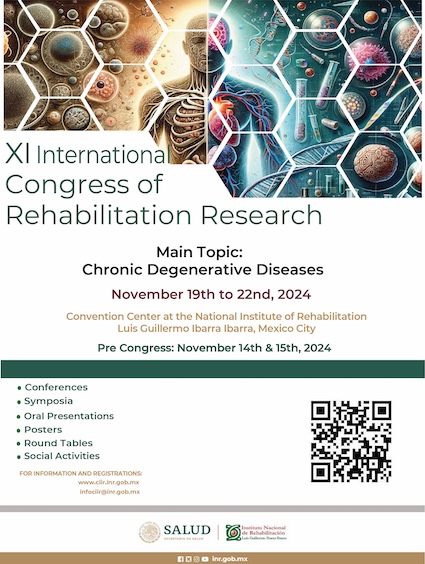Attendance Index of rehabilitation treatment in adolescents with cerebral palsy at a northwest mexican center
Keywords:
Outpatient, adolescent, cerebral palsy, rehabilitation, physical medicine and rehabilitationAbstract
Therapeutic adherence is a complex and multifactorial phenomenon. Rehabilitation treatment is an important part in the management of patients with cerebral palsy (CP) and is necessary to reduce complications and functional impairment. Calculating the assistance ratio gives an accurate indicator of the degree to which patients adhere to treatment. The objective was to determine the characteristics associated with the rate of assistance to rehabilitation treatment in adolescent patients with CP. This is an observational, transversal and descriptive study. CP patients included adolescents from 10 to 18 years old who that assist to the Rehabilitation Center in the period from January to December 2014. The information was obtained from medical records. 62 patients were obtained with an average age of 13.58 ± 2.55 years; 69.4% male. The predominant type of CP was spastic bilateral (80.6%) and level V of the GMFCS (43.5%). The average attendance ratio was 0.71 ± 0.14. The population was divided into groups of patients with poor and good attendance, only to be reported statistically significant level attendance ratio with the place of residence of patients (p = 0.007) and a moderate correlation in the perception of lack of economical resources and attendance ratio (r = 0.56). Only the living outside the city where the rehabilitation center is found to be a factor in the adherence in this group of patients. The other clinical or demographic characteristics showed no association.
References
Bassett S. The assessment of patient adherence to physiotherapy. NZ J Physiother. 2003; 31 (2): 60-66.
Silva GE, Galeano E, Correa JO. Adherencia al tratamiento implicaciones de la no-adherencia. Acta Med Colomb. 2005; 30 (4): 268-273.
Jack K, McLean SM, Moffett JK, Gardiner E. Barriers to treatment adherence in physiotherapy outpatient clinics: a systematic review. Man Ther. 2010; 15 (3): 220-228. doi:10.1016/j.math.2009.12.004
Herman K. Barriers experienced by parents/caregivers of children with clubfoot deformity attending specific clinics in Uganda [dissertation] Republic of South Africa: University of the Western Cape. 2006.
Borrás ST. Adolescencia: definición, vulnerabilidad y oportunidad. Correo Científico Médico de Holguin. 2014; 18 (1): 5-7.
Adrián F. Análisis de la adherencia a los tratamientos kinésicos. Revista del Hospital J.M. Ramos Mejía. 2007; 12 (1): 1-31.
Galil A, Carmel S, Lubetzky H, Vered S, Heiman N. Compliance with home rehabilitation therapy by parents of children with disabilities in Jews and Bedouin in
Israel. Dev Med Child Neurol. 2007; 43 (4): 261-268.
doi: 10.1111/j.1469-8749.2001.tb00200.x
Berker AN, Yalc MS. Parálisis cerebral: aspectos ortopédicos y rehabilitación. Pediatr Clin N Am. 2008;
: 1209-1225. doi:10.1016/S0186-159X(08)55089-3 9. Reddihough DS, Collins KJ. The epidemiology and causes of cerebral palsy. Aust J Physiother. 2003; 49
(1): 7-12.
Guía de Práctica Clínica Abordaje y manejo del niño
con parálisis cerebral infantil con comorbilidades neurológicas y musculoesqueléticas. México: Secretaría de Salud, 2010.
Redmond R, Parrish M. Variables influencing physiotherapy adherence among young adults with cerebral palsy. Qual Health Res. 2008; 18 (11): 1501- 1510. doi: org/10.1177/1049732308325538
Sabit R, Griffiths TL, Watkins AJ, Evans W, Bolton CE, Shale DJ et al. Predictors of poor attendance at an outpatient pulmonary rehabilitation programme. Respiratory Medicine. 2008; 102 (6): 819-824. doi: 10.1016/j.rmed.2008.01.019
Asefzadeh S, Asefzadeh M, Javadi H. Care Management: Adherence to Therapies Among Patients at Bu-Alicina Clinic, Qazvin, Iran. JRMS. 2005; 10 (6): 343-348.
Law, M, King G. Parent compliance with therapeutic interventions for children with cerebral palsy. Dev Med Child Neurol. 1993; 35 (11): 983-990. doi: 10.1111/ j.1469-8749.1993.tb11580.x
Jin J, Sklar GE, Min Sen Oh V, Chuen Li S. Factors affecting therapeutic compliance: A review from the patient’s perspective. Ther Clin Risk Manag. 2008; 4 (1): 269-286.
Batysheva TT, Bykova OV, Vinogradov AV. Family’s adherence to treatment of the child with a neurological pathology. Zh Nevrol Psikhiatr Im S S Korsakova. 2012; 112 (7 Pt 2): 56-63.
Aliabadi S, Hatamizadeh N, Vamghi R, Kazemnejad A. Children with disability: barriers to regular attendance in rehabilitation sessions. J Res Rehabil Sci. 2012; 8 (5): 959-969.
Downloads
Published
How to Cite
Issue
Section
License
Copyright (c) 2017 Instituto Nacional de Rehabilitación Luis Guillermo Ibarra Ibarra

This work is licensed under a Creative Commons Attribution 4.0 International License.
© Instituto Nacional de Rehabilitación Luis Guillermo Ibarra Ibarra under a Creative Commons Attribution 4.0 International (CC BY 4.0) license which allows to reproduce and modify the content if appropiate recognition to the original source is given.



